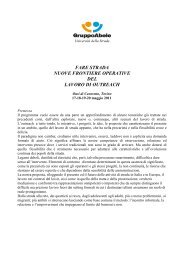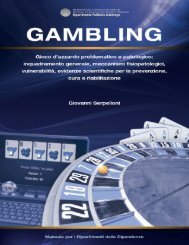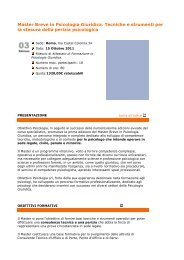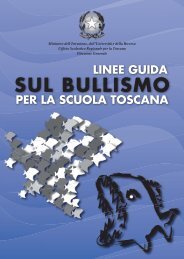Neuroscienze e dipendenze - Dipartimento per le politiche antidroga
Neuroscienze e dipendenze - Dipartimento per le politiche antidroga
Neuroscienze e dipendenze - Dipartimento per le politiche antidroga
You also want an ePaper? Increase the reach of your titles
YUMPU automatically turns print PDFs into web optimized ePapers that Google loves.
I VIEDOGIOCHI VIOLENTI POSSONO INDDURRE COMPORTAMENTI AGGRESSIVI NEI RAGAZZI … - 189<br />
81. Law<strong>le</strong>r, K.A.; Harralson, T.L.; Armstead, C.A.; Schmied, L.A. (1993). Gender and cardiovascular responses: what is the ro<strong>le</strong> of hostility Journal<br />
of psychosomatic Research. Vol.37, pp. 603-613.<br />
82. Le Diberder, Alain; Le Diberder, Frédéric (1993). Chi ha paura dei videogiochi (trad.it. Irene Bitelli, E<strong>le</strong>na Carnero). Multi Media, anno II,<br />
n.2, pp. 31-50.<br />
83. Lee R, Coccaro E. The neuropsychopharmacology of criminality and aggression. Can J Psychiatry. 2001 Feb;46(1):35-44<br />
84. Leerhsen, C.; Zabarasky, M.; McDonald, D (1983). Video games zap Harward. Newsweek, 101, pag.92.<br />
85. Leventhal, H. (1980). Toward a comprehensive theory of emotion. In Berkowitz, L. (ed.). Advances in ex<strong>per</strong>imental social psychology.<br />
New York: Academic Press. Liebert, R.; Sprafkin, J.; Davidson, E. (1982). The early window: effects of te<strong>le</strong>vision on children and youth<br />
(2nd ed.). New York: Pergamon Press.<br />
86. Lin, S.; Lep<strong>per</strong>, MR (1987). Correlates of children’s usage of video games and computers. Journal of Applied Social Psychology 17, pp.72-<br />
93.<br />
87. Loftus, G. R.; Loftus, E. F (1983). Mind at play: the psychology of video games. Basic Books: New York.<br />
88. Lorenz, K (1963). Das Sogenannte Böse. Vienna: Borotha-Schoe<strong>le</strong>r (trad.it. L’aggressività, Milano, Il Saggiatore, 1969).Lurçat, L.; (1990).<br />
Impact de la vio<strong>le</strong>nce télévisuel<strong>le</strong>, in Enfance, Tomo 43, n.1.<br />
89. Maeda, Y.; Kurokawa, T.; Sakamoto, K.; et al (1990). E<strong>le</strong>ctroclinical study of video-game epi<strong>le</strong>psy. Dev Med Child Neurol 32, pp.493-500.<br />
90. Mand<strong>le</strong>r, G. (1980). The generation of emotion: a psychological theory. In Plutchik, R.; Kel<strong>le</strong>rman, H. (a cura di) Emotion: Theory, Research<br />
and Ex<strong>per</strong>ience. Academic press, New York.<br />
91. Mathiak K, Weber R. Toward brain correlates of natural behavior: fMRI during vio<strong>le</strong>nt video games. Hum Brain Mapp. 2006<br />
Dec;27(12):948-56<br />
92. McClure, R.F.; Mears, F.G (1984). Video game players: <strong>per</strong>sonality characteristics and demographic variab<strong>le</strong>s. Psychological Reports, 55,<br />
pp.271-276.<br />
93. McClure, R.F.; Mears, F.G (1986). Video game playing and psychopathology. Psychol. Reports, Vol.59, pp.59-62.<br />
94. McDougall, W (1908). Introduction to Social Psychology. London: Methuen.<br />
95. Milgram, S. (1963), Behavioral study of obedience. Journal of Abnormal and Social Psychology. Vol.67, pp.371-378.<br />
96. Millar, Susanna. (1974). La psicologia del gioco infanti<strong>le</strong>. Boringhieri. Titolo origina<strong>le</strong>: The Psychology of Play, Penguin Books, Harmondsworth,<br />
Midd<strong>le</strong>sex, 1968.<br />
97. Miczek KA, de Almeida RM, Kravitz EA, Rissman EF, de Boer SF, Raine A. Neurobiology of escalated aggression and vio<strong>le</strong>nce. J Neurosci.<br />
2007 Oct 31;27(44):11803-6<br />
98. Mül<strong>le</strong>r JL, Sommer M, Weber T, Hajak G. [Neurobiology of vio<strong>le</strong>nce: results of empirical and ex<strong>per</strong>imental studies of reactive vio<strong>le</strong>nce]<br />
Psychiatr Prax. 2004 Nov;31 Suppl 1:S50-1<br />
99. Murray, J. P. (1998). Studying te<strong>le</strong>vision vio<strong>le</strong>nce: A research agenda for the 21st century. In J. K. Asamen & G. L. Berry (Eds.), Research<br />
paradigms, te<strong>le</strong>vision, and social behavior (pp. 369–410).<br />
100. Murray JP, Liotti M, Ingmundson PT, Mayberg HS, Pu Y, Zamarripa F, Liu Y, Woldorff MG, Gao JH. Children’s Brain Activations Whi<strong>le</strong> Viewing<br />
Te<strong>le</strong>vised Vio<strong>le</strong>nce Revea<strong>le</strong>d by fMRI. Media Psychology 2006 8, 25–37<br />
101. Nelson, J.; Gelfand, D.; Hartmann, D. (1969). Children’s aggression following competition and exposure to an aggressive model. Child-<br />
Development, Vol.40, pp. 1085-1097.<br />
102. Neuburger de Cataldo, Luisella (1996). Vio<strong>le</strong>nza e apprendimento tra tecno-immaginario e apparizioni immateriali. In Neuburger de Cataldo,<br />
Luisella (a cura di), Mass Media, Vio<strong>le</strong>nza e Giustizia Spettacolo. ISISC, Atti e Documenti, vol.11. CEDAM: Padova.<br />
103. Orlick, T.D. (1981). Positive socialization via coo<strong>per</strong>ative games. Developmental Psychology. Vol.17, pp.426-429.<br />
104. Pecora, N., Murray, J. P., & Wartella, E. (Eds.). (2006). Children and te<strong>le</strong>vision: 50 years of research. Mahwah, NJ: Lawrence Erlbaum Associates,<br />
Inc.<br />
105. Pellizzari, Tommaso (1999). Macché mamma, voglio Lara. In Sette, 7 Gennaio, n.1, pp. 26-32.<br />
106. Provenzo, Eugene F. (1991). Video kids: making sense of Nintendo. Cambridge, MA. Harward University Press.<br />
107. Salvini, A. (1988). Il rito aggressivo. Giunti: Firenze.<br />
108. Scott, Derek (1995). The effect of video games on feelings of aggression. Journal of Psychology, Mar Vol 129 (2) pp. 121-132.<br />
109. Segal, K.; Dietz, W.H. (1991). Physiologic responses to playing a video game. Am J Dis Child. Vol. 145, pp. 1034-6.<br />
110. Selnow GW. (1984). Playing videogames: the e<strong>le</strong>ctronic friend. Journal of Communication, Vol 34 (2), pp. 148-156.<br />
111. Sherif, M.; Sherif, C.W.; (1985). Groups in harmony and tension. New York: Har<strong>per</strong>.<br />
112. Shimai, Satoshi; Masuda, Kimio; Kishimoto, Youichi (1990). Influences of TV games on physical and psychological development of Japanese<br />
kindergarten children. Perceptual and Motor Skills, Jun Vol 70 (3, Pt 1) pp. 771-776.<br />
113. Silverman, L.; Sprafkin, J. (1980). The effects of Sesame Street’s prosocial spots on coo<strong>per</strong>ative play between young children. Journal<br />
of Broadcasting. Vol.24, pp. 135-147.<br />
114. Silvern, Steven B.; Williamson, Peter A (1987). The effects of video game play on young children’s aggression, fantasy, and prosocial behavior.<br />
Journal of Applied Developmental Psychology, Oct-Dec Vol 8 (4) pp. 453-462.<br />
115. Singer, D. (1982). Te<strong>le</strong>vision and the developing imagination of the child. In Pearl, et.al. (a cura di) Te<strong>le</strong>vision and Behavior, U.S. Government<br />
Printing Office, Washington.<br />
116. Skirrow, G. (1990): “Hellivision”: an analysis of video games’ in Manuel Alvarado & John O. Thompson (Eds). The Media Reader. London:<br />
British Film Institute.<br />
117. Sprafkin, J.; Liebert, R.; Poulos, R. (1975). Effects of a prosocial te<strong>le</strong>vised examp<strong>le</strong> on children’s helping. Journal of Ex<strong>per</strong>imental Child.<br />
Vol.20, pp.119-126.<br />
118. Staub, E. (1971). Use of ro<strong>le</strong> playing and induction in children’s <strong>le</strong>arning of helping or sharing behavior. Child Development. Vol. 42,<br />
pp.805-816.<br />
119. Subrahmanyam, Kaveri; Greenfield, Patricia M (1996). Effect of video game practice on spatial skills in girls and boys. In Patricia M.<br />
120. Greenfield, Rodney R. Cocking (Eds.), Interacting with video. Advances in applied developmental psychology, Vol. 11, pp. 95-114.<br />
121. Thomas, M.H.; Drabman, R.S. (1975). To<strong>le</strong>ration of real-life aggression as a function o f exposure to te<strong>le</strong>vised vio<strong>le</strong>nce and age of subjects.<br />
Merril-Palmer Quarterly. Vol.21, pp. 227-232.<br />
122. Thomas, M.H.; Horton, R.W.; Lippincott, E.C.; Drabman, R.S. (1977). Desensitization to portrayals of real-life aggression as a function of












